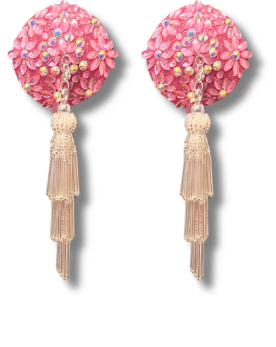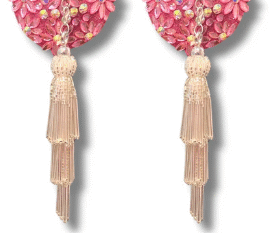
Nipple pasties are adhesive coverings designed to conceal the nipples, often worn for fashion, modesty, or comfort under sheer or revealing clothing. They serve as an alternative to bras, providing coverage without the bulk or straps.
They come in various shapes, sizes, and materials to suit different needs, from discreet everyday wear to bold, decorative styles for performance or special occasions. Understanding their use and options can help individuals choose the right type for their specific situation.
What Are Nipple Pastys?
Nipple pastys are small adhesive coverings designed to conceal the nipples. They serve various functions, from fashion to performance, and come in multiple shapes and styles to suit different needs.
History of Nipple Pastys
Nipple pastys date back to the 1920s during the burlesque era, when performers wanted to comply with modesty laws while still appearing provocative. Initially made from fabric and adhesive tape, they were functional yet decorative elements of stage costumes.
Their popularity grew in the 1940s and 50s, often adorned with sequins or tassels, reinforcing their role in entertainment. Over time, nipple pastys became part of mainstream fashion and self-expression, shifting from strictly performance wear to personal style accessories.
Popular Uses and Occasions
Nipple pastys are used primarily to prevent nipple exposure under sheer or tight clothing. They are popular at events like music festivals, fashion shows, and burlesque performances where minimal coverage is desired.
They also serve a practical role during photo shoots or runway shows to comply with modesty standards without wearing a full bra. Additionally, some wear pastys for comfort or confidence when going braless in public.
Different Styles and Shapes
Nipple pastys vary widely in material, shape, and design. Common shapes include circles, stars, and hearts, often made from silicone, fabric, or latex. Some are plain and skin-toned for subtlety, while others are decorative with sequins, gems, or prints.
Adhesive type varies too, with reusable silicone pastys offering durability and single-use fabric options providing ease. The choice depends on the intended look, comfort, and occasion.
Choosing and Caring for Nipple Pastys
Selecting nipple pastys involves understanding the material, application process, and whether to choose reusable or disposable types. Proper care ensures comfort, effectiveness, and longer usability.
How to Select the Right Material
Different materials impact comfort, adhesion, and skin sensitivity. Silicone pastys offer a smooth finish and are gentle on skin, suitable for sensitive users but tend to be pricier. Fabric options allow breathability and variety in design but may not stick as firmly during intense activity.
Latex pastys provide strong adhesion but often trigger allergies and irritation. Vinyl and plastic pastys offer a shiny appearance but can trap moisture, increasing discomfort. Users should test a patch to check for allergic reactions before full use.
Choosing based on occasion is key: silicone or fabric for long wear, latex or vinyl for short-term or specific looks. Skin type plays a major role in material choice.
Application and Removal Tips
Clean, dry skin is crucial before applying pastys for maximum adherence. Avoid lotions or oils on the skin beforehand. Applying pressure for 10-15 seconds helps secure the adhesive.
To remove, gently peel from the edges toward the center to avoid skin damage. Using a little warm water or oil like baby oil loosens adhesive residue. Never rip them off as it can cause irritation or pain.
After removal, clean the skin with mild soap and moisturize to prevent dryness. For reusable pastys, follow specific cleaning instructions to maintain stickiness.
Reusable vs Disposable Options
Reusable pastys are more cost-effective over time but require proper cleaning and storage to maintain adhesion. They often feature silicone or medical-grade materials intended for repeated use.
Disposable pastys provide convenience and hygiene, ideal for one-time wear. They usually come with strong adhesives but may cause irritation in some users as they are less breathable.
The choice depends on frequency of use and skin sensitivity. Reusable options suit regular wearers who can invest in care. Disposable are better for occasional users or events where quick disposal is preferred.
| Feature | Reusable | Disposable |
| Cost | Higher upfront, lower long term | Low upfront, repetitive purchases |
| Adhesion | Maintained with care | Strong but one-time use |
| Skin-friendliness | Generally gentler | Can cause irritation |
| Cleaning | Required | Not applicable |
Kongo Tech Leading Innovation in African Technology Solutions
Kongo Tech specializes in developing innovative digital solutions tailored to African mark…





